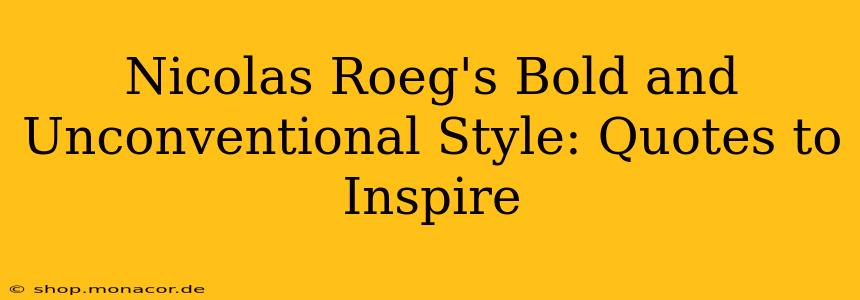Nicolas Roeg, the visionary filmmaker behind such cinematic masterpieces as Don't Look Now, Walkabout, and The Man Who Fell to Earth, wasn't just a director; he was a cinematic poet, a visual sorcerer weaving narratives with a bold and unconventional style that continues to inspire filmmakers and cinephiles alike. His films, characterized by their jarring juxtapositions, dreamlike sequences, and unsettling beauty, challenged conventional storytelling and pushed the boundaries of cinematic expression. This exploration delves into Roeg's unique approach, examining the elements that make his work so compelling and using his own words (and those of others about his work) to illuminate his singular vision.
Roeg's Mastery of the Unconventional: A Visual Feast
Roeg's style defied categorization. He wasn't afraid to experiment, to disrupt the flow of a narrative with unexpected cuts and jarring shifts in tone. This wasn't simply stylistic flourish; it was a deliberate attempt to mimic the fragmented nature of memory, the irrationality of dreams, and the unpredictable chaos of life itself. He masterfully employed techniques like jump cuts, reverse chronology, and subjective camerawork to disorient and engage the viewer, drawing them deeper into the emotional landscape of his films. His visual storytelling transcended mere narrative; it was an experience, an emotional journey.
How did Nicolas Roeg influence cinema?
Nicolas Roeg's influence on cinema is profound and far-reaching. He fundamentally altered the way filmmakers approached visual storytelling, embracing experimentation and challenging traditional narrative structures. His unconventional use of editing techniques, like jump cuts and non-linear storytelling, opened up new possibilities for cinematic expression. Many contemporary filmmakers, particularly those working within the arthouse or independent cinema sphere, owe a debt to Roeg's pioneering spirit and his willingness to push boundaries. His influence can be seen in the work of directors who similarly prioritize visual storytelling, creating cinematic experiences rather than simply narrating events.
What is the style of Nicolas Roeg's films?
Roeg's style is often described as surreal, dreamlike, and deeply unsettling. His films are characterized by their fragmented narratives, disorienting editing techniques (like jump cuts), and a profound sense of ambiguity. He frequently employed unconventional camerawork, including subjective shots and unsettling close-ups, to draw the viewer into the characters' perspectives and emotional states. His use of color, light, and shadow also contributes significantly to the overall mood and atmosphere, creating a visual tapestry that is both beautiful and unnerving. Beyond this visual tapestry, Roeg often dealt with complex themes such as mortality, obsession, and the unsettling aspects of human relationships, amplifying the tension and unease his visuals evoke.
What are the key themes in Nicolas Roeg's films?
Recurring themes in Roeg's films include the complexities of human relationships, often exploring the darker sides of love, obsession, and betrayal. He frequently tackled the fragility of the human psyche, delving into the subconscious and the irrational aspects of human behavior. Mortality and the confrontation with death are also prominent motifs. He wasn't afraid to explore unsettling themes, creating a sense of unease and ambiguity that often lingers long after the credits roll. The exploration of perception and reality, and the blurring of the lines between the two, also defines many of his works. This ambiguity, combined with his unique visual style, results in films that reward multiple viewings and inspire continued discussion and interpretation.
What makes Nicolas Roeg's films so unique?
The uniqueness of Roeg's films stems from his audacious blending of visual storytelling, unconventional editing, and a profound thematic depth. He didn't shy away from challenging the audience, forcing them to actively engage with his narratives rather than passively consuming them. His films demanded attention, prompting viewers to reflect on the themes explored and the unsettling ambiguity inherent in his work. This combined effect of visual experimentation, non-linear narrative structure, and provocative thematic content sets Roeg’s filmography apart, ensuring its lasting impact on cinematic history.
Inspiring Quotes from and About Nicolas Roeg:
While Roeg himself was notoriously private and not one for extensive interviews, his work speaks volumes. The impact of his films, however, is best understood through the lens of others who have analyzed his artistic contributions. The quotes below, both directly from Roeg and from critics and admirers, encapsulate his unique approach to filmmaking:
-
"I'm interested in the unexpected. I like things to happen that you don't expect." – Nicolas Roeg. This succinctly reveals his dedication to shattering cinematic conventions.
-
"I try to make films that are more like dreams than reality." – Nicolas Roeg. This highlights the dreamlike, surreal quality permeating his works.
-
"[Roeg's films]…are not about plot but about atmosphere, mood, and texture." – This statement from a critic accurately pinpoints the importance of ambiance in his cinematic landscape.
-
"Roeg is a master of visual storytelling, creating images that are both beautiful and unsettling." – This speaks to the duality of his aesthetic; his films captivate while simultaneously challenging and disturbing.
Nicolas Roeg's legacy extends far beyond individual films. He gifted the world a unique cinematic language, one that prioritized visual poetry over linear narrative, leaving a lasting impact on the art of filmmaking. His unconventional approach, his daring experiments, and his unwavering dedication to his artistic vision continue to inspire filmmakers and cinephiles, proving his place as one of cinema's most singular and influential voices.

